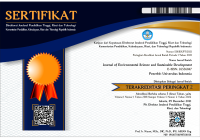Abstract
This current study is focused on measuring the life cycle assessment of the sustainability of sago palm cultivated on peatlands. A previous theory suggested that while food production tends to increase arithmetically, population tends to increase naturally at a faster geometric rate that may cause hunger and/or starvation in the future generation. Land is a limited resource, and to address the rapidly increasing population, peatland cultivation has become popular as a result in the recent times. Rice is the main staple food in Indonesia with a consumption of >90 kg/capita/year. Sago palm is an indigenous plant that abundantly grows in both mineral soils and peatlands all over Indonesia. The aim of this research was to recommend the sustainability of sago palm as a staple food resource in order to ascertain if it is a contributor to climate change. The method of life cycle sustainability assessment (LCSA) that consists of Life Cycle Assessment (LCA), Life Cycle Costing (LCC), and Social Life Cycle Assessment (SLCA) was used through the dashboard tool. Our results suggest that sago palm cultivated on peatlands falls in the “sustainable” category when assessed based on the social, economic, and environmental aspects of sustainability.
Recommended Citation
Wulan, Saptarining
(2018).
SAGO AS AN ENVIRONMENTALLY SUSTAINABLE FOOD RESOURCE IN THE CLIMATE CHANGE ERA.
Journal of Environmental Science and Sustainable Development, 1(1), 53-73.
Available at: https://doi.org/10.7454/jessd.v1i1.22






